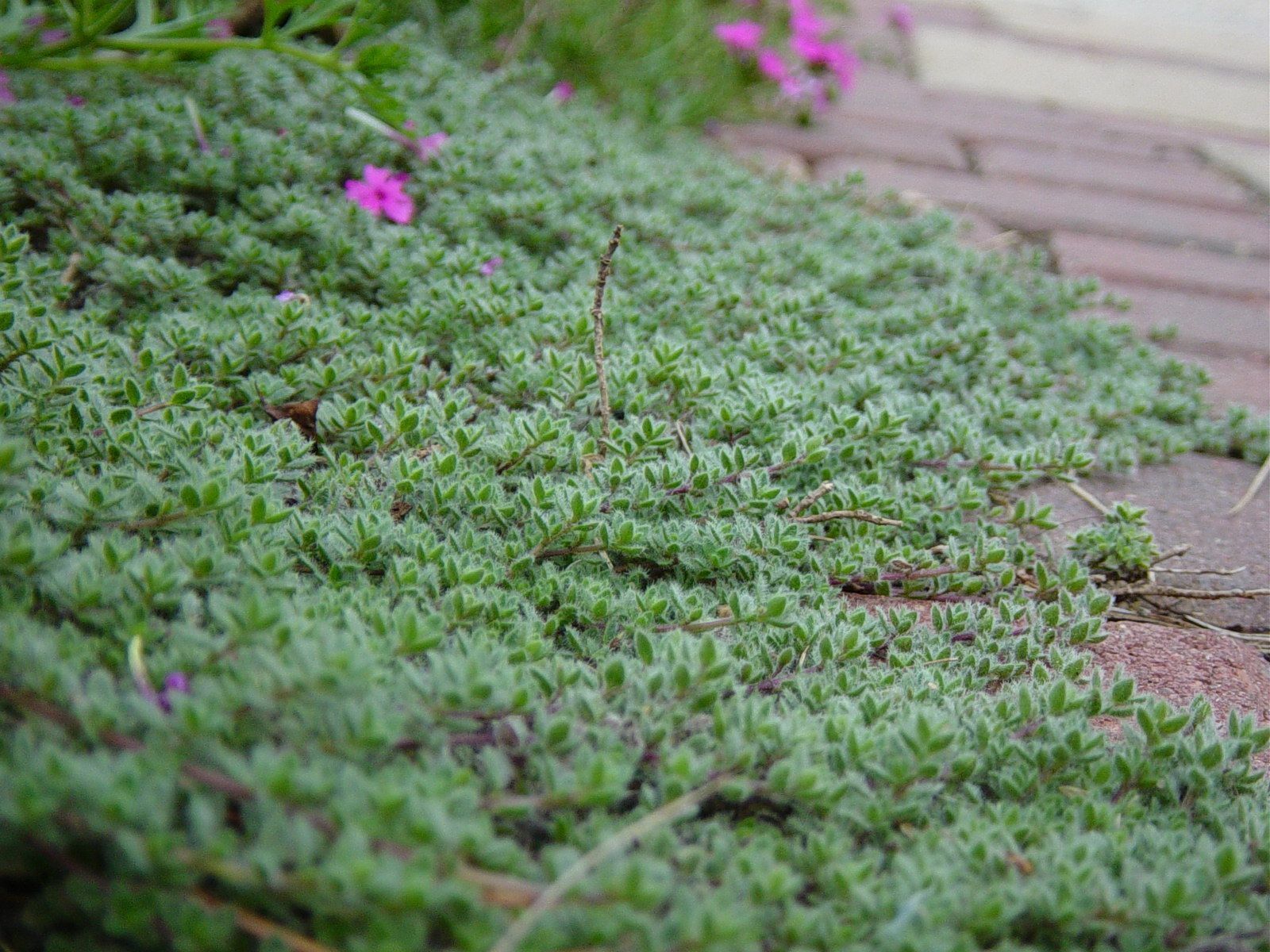An excellent alternative to the traditional lawn is a mesmerizing carpet of creeping thyme. It’s easier to maintain and requires less watering compared to the usual grass. Moreover, every summer, the creeping thyme blankets your yard with a stunning array of pink, purple, or magenta-red flowers, something that a regular lawn can never achieve. Furthermore, a creeping thyme lawn thrives under the full sun and doesn’t suffer from scorching like conventional turfgrass.
Creeping thyme is among the numerous plants that serve as a substitute for a lawn. This fast-spreading plant quickly takes root in the soil, and its evergreen foliage remains green throughout the year. Due to its suitability for xeriscaping, creeping thyme is a favored choice to replace traditional grasses in lawns.
What is it about a creeping thyme lawn that makes it so popular as a ground cover plant instead of a regular lawn? Is it easy to maintain such a lawn? And how can one transform an existing lawn into a creeping thyme paradise? These questions and more will be answered in this article.
What is a Creeping Thyme Lawn?
A creeping thyme lawn is a remarkable substitute for turfgrass. Varieties of low-growing thyme, like the red creeping thyme known as Thymus serpyllum ‘Coccineus,’ only reach a height of 2 to 3 inches (5 – 7.5 cm). These ground-covering thyme plants spread effortlessly, creating a lush carpet of green foliage that requires minimal maintenance.
But why should one seek an alternative to a traditional lawn? Why not continue to maintain the existing turfgrass to enhance the aesthetic appeal of one’s property?
It’s important to remember that lawns serve a purpose beyond appearances. Maintaining a flourishing and healthy lawn is beneficial for the environment.
For instance, a lawn reduces the prevalence of hard surfaces like brick pavements and concrete in your yard. Additionally, the evergreen vegetation plays a crucial role in purifying the air, capturing carbon dioxide, preventing soil erosion, reducing noise levels, and lowering temperatures.
However, maintaining a turfgrass lawn can be costly. In Southern states such as Florida, for example, it takes around 0.62 gallons of water per square foot each week to keep the lawn healthy and green. Therefore, considering a lawn substitute is a wise choice, especially when it comes to creeping thyme. This versatile plant functions similarly to a regular lawn by capturing CO2, reducing noise, preventing water runoff, and purifying the air. However, due to its drought tolerance and preference for full sun, a creeping thyme lawn requires fewer resources to maintain.
Types of Creeping Thyme Lawns
Plants suitable for a creeping thyme lawn should have a low growth habit, be able to withstand moderate foot traffic, and require minimal maintenance. So, what are the finest varieties of creeping thyme to replace your turfgrass lawn? Here are four types of creeping thyme plants suitable for creating a picturesque lawn.
Red Creeping Thyme Lawn (Thymus serpyllum ‘Coccineus’)
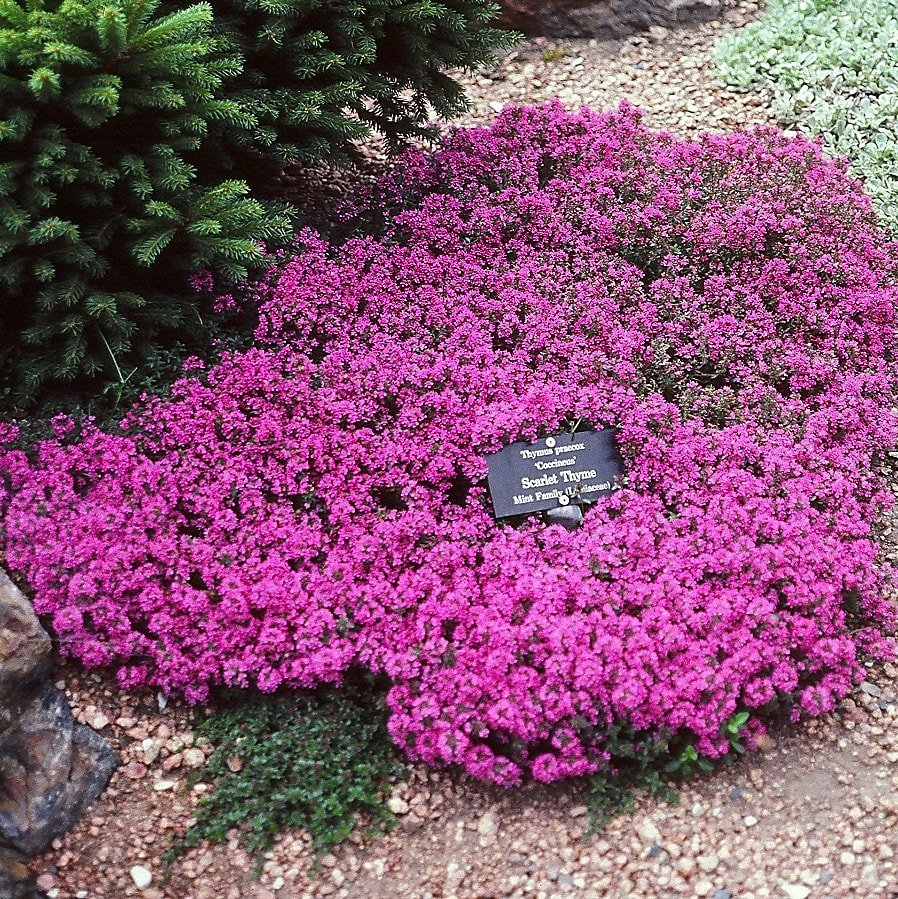
Red creeping thyme is a popular lawn alternative due to its low-growing habit, evergreen foliage, and deep reddish-pink flowers. Red creeping thyme lawns reach a height of up to 3 inches (7.5 cm) and spread extensively as their stems take root in the soil. The vivid pink flowers bloom throughout the summer season.
Purple Creeping Thyme Lawn (Thymus serpyllum)
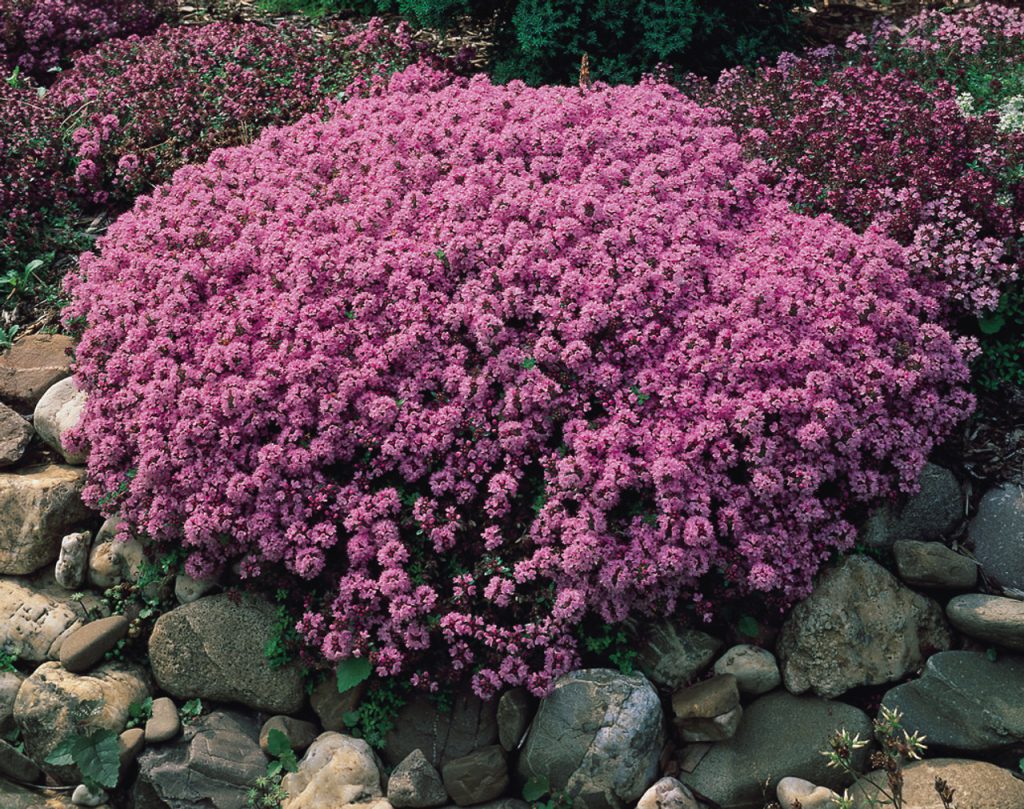
A purple creeping thyme lawn displays an alluring carpet of glossy dark green leaves adorned with aromatic purple flowers. The small purple flowers of this ground-covering plant are attractive star-shaped blossoms. Walking on a purple creeping thyme lawn releases a refreshing minty fragrance due to its herbal nature.
Pink Creeping Thyme Lawn (Thymus serpyllum ‘Elfin’)
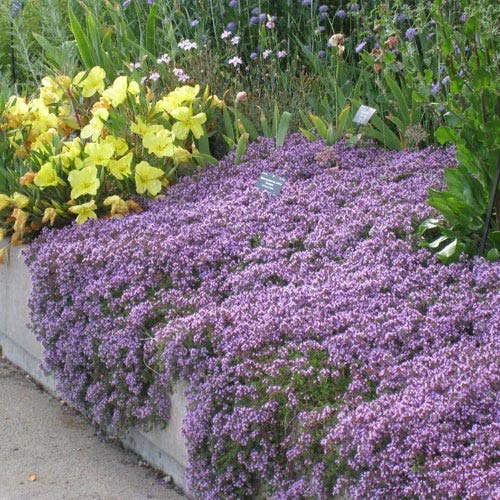
The Elfin cultivar of creeping thyme is an ideal choice for creating a pink creeping thyme lawn. This low-spreading plant features fragrant, glossy green oval leaves and abundant pinkish-purple flowers, creating a stunning display of colors during the summer. This creeping thyme lawn grows between 1 to 3 inches (2.5 – 7.5 cm) tall and spreads rapidly.
Woolly Creeping Thyme Lawn (Thymus pseudolanuginosus)
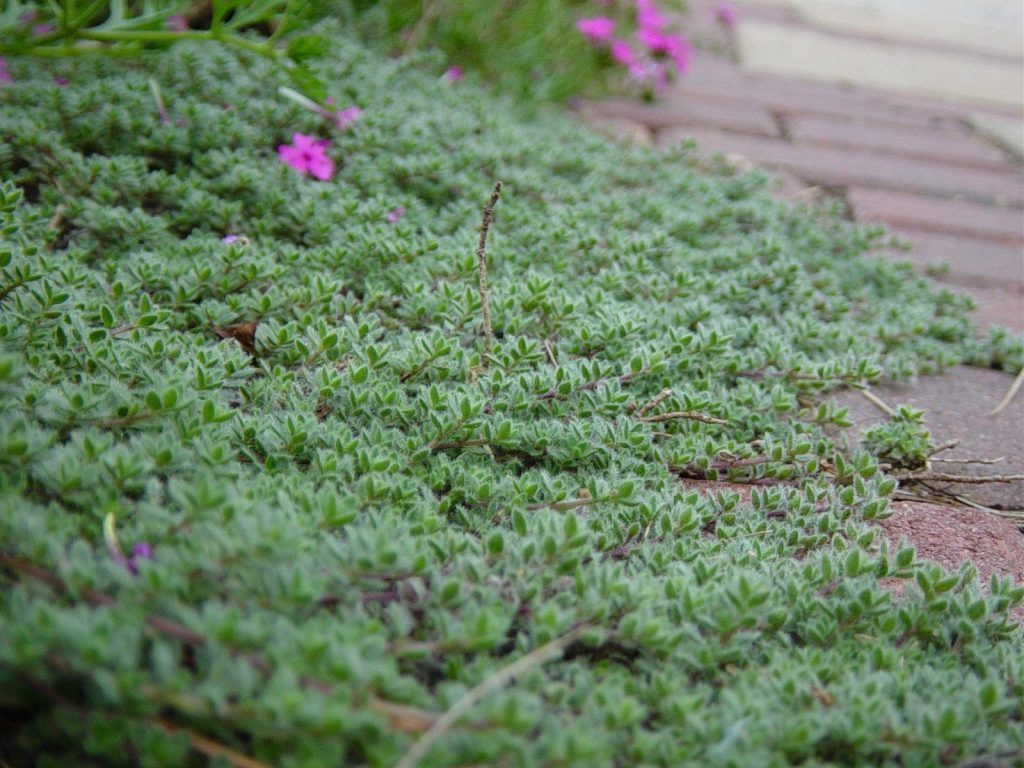
Woolly creeping thyme is a pink-flowering ground cover plant with unique characteristics suitable for a lawn alternative. This creeping thyme variety is distinguished by its fuzzy leaves, emitting a delightful rosemary aroma. Additionally, the flowering plant showcases pale pink flowers and reaches a height of 3 inches (7.5 cm).
The Benefits of a Creeping Thyme Lawn
Choosing creeping thyme as a grass substitute provides several advantages. It grows rapidly without requiring much maintenance. Creeping thyme doesn’t demand excessive watering, fertilizing, or mowing. Other benefits include its ability to withstand light foot traffic and enhance the appearance of your yard.
Here are seven benefits of growing a creeping thyme lawn in your front or backyard:
1. Excellent flowering ground cover: Red creeping thyme and other varieties stay below 3 inches (7.5 cm) in height, making them perfect ground cover plants. With a moderate growth rate and spreading nature, they create a captivating carpet over bare ground, keeping your yard lush throughout the year.
2. No mowing required: All creeping thyme varieties suitable for lawns hardly need any mowing. Their natural height remains low, eliminating the need to maneuver a lawnmower. Furthermore, a creeping thyme lawn requires minimal maintenance, preventing weed growth.
3. Aromatic leaves and flowers: Planting a creeping thyme lawn fills your yard with pleasant fragrances. Thyme belongs to the mint family, Lamiaceae. Walking on a creeping thyme lawn releases essential oils, providing a delightful minty aroma. Additionally, thyme leaves can be used to add flavor to your food.
4. Withstands foot traffic: Red creeping thyme, woolly thyme, and other varieties make excellent lawn alternatives due to their ability to withstand light to moderate foot traffic. The resilient woody stems of creeping thyme bounce back, showing no signs of wear and tear. Moreover, their drought tolerance contributes to a highly durable lawn.
5. Requires less water than turfgrass: If you desire a vibrant green lawn without frequent watering, creeping thyme ground cover plants are the solution. A creeping thyme lawn demands only a fraction of the water required by traditional lawns. Therefore, even in hot, sunny weather, thyme lawns remain resilient, maintaining their green hue without signs of stress, browning, or withering.
6. Ideal for xeriscaping: Growing a creeping thyme lawn is perfect for xeriscaping, where water conservation is essential. Once established, creeping thyme plants thrive with little more than natural rainfall, provided the soil is well-draining. In fact, the quality of their essential oils improves during drought conditions.
7. Deer resistant: If deer pose a problem in your area, planting a creeping thyme lawn is an excellent choice. Deer tend to avoid creeping thyme, opting for tastier treats. This lawn substitute is rarely on a deer’s menu.
Disadvantages of a Creeping Thyme Lawn
Despite the numerous benefits of a creeping thyme lawn, there are some drawbacks to consider. For instance, thyme ground cover plants require full sun and well-drained soil. Therefore, not all areas of your yard may be suitable for this lawn alternative. Let’s explore other considerations when growing a creeping thyme lawn.
1. Higher cost: Cost is the primary drawback of planting a creeping thyme lawn instead of traditional turfgrass. Acquiring thyme seedlings can be more expensive than sowing grass seeds. Moreover, thyme seed germination can be challenging. Starting with a small area and allowing the thyme to spread gradually over the years is the recommended solution.
2. Inadequate shade tolerance: Growing a creeping thyme lawn is not practical in shaded areas. Even partial shade negatively affects creeping thyme, resulting in leggy and sparse growth. Additionally, thyme in shady conditions is more susceptible to pests and weeds.
3. Requires well-drained soil: One disadvantage of using creeping thyme as a substitute for turfgrass is its requirement for excellent soil drainage. Thyme roots are prone to root rot if the soil becomes excessively wet or waterlogged. Overly moist soil can lead to the demise of the ground cover plants.
4. Installation time: Transforming a traditional grass lawn into a creeping thyme lawn requires more time and effort. It is not a quick-fix solution for replacing your lawn. The spreading nature of the plant necessitates a few years to establish dense, evergreen ground cover. Instantly purchasing rolls of ready-to-install thyme lawns is not possible.
5. Attracts pollinators: While attracting pollinators to your yard is generally desirable, the profusion of purple flowers throughout summer can attract an overwhelming number of bees. Depending on the size of your lawn and your tolerance for flying, stinging insects, a creeping thyme lawn may not be suitable for everyone.
Creeping Thyme Lawn vs. Traditional Lawn
Compared to typical turfgrass lawns, creeping thyme lawns require less water. They are more resilient in hot weather, and their evergreen foliage remains lush and green even under scorching sun. Additionally, a creeping thyme lawn adds a splash of vibrant colors, with purple, reddish, and pink flowers, creating a picturesque summer landscape that traditional lawns cannot match.
How to Plant a Creeping Thyme Lawn
While installing an aromatic creeping thyme lawn requires more effort than laying traditional sod, the process is not difficult, and the results are rewarding. Furthermore, once established, a creeping thyme lawn demands less maintenance and fewer resources compared to a traditional lawn, while still looking lush and healthy.
To replace an existing lawn, the first step is to remove the turfgrass. The easiest method is to cover the existing grass with cardboard and mulch for one season. This effectively kills the grass, allowing you to plant creeping thyme directly into the ground the following season.
Alternatively, you can opt for a faster approach, which involves physically removing the grass. Afterward, till the soil to eliminate large items such as roots, rocks, and debris. Finally, prepare the soil for planting by adding bone meal to enhance nutrient content.
Once the soil is ready in early spring, plant thyme plugs 8 inches (20 cm) apart and water thoroughly. As the creeping thyme grows, it will spread horizontally, filling in the gaps and creating a low-maintenance lawn. Regular watering during the first few months helps establish the roots.
In the first year, expect the thyme plants to grow slowly. However, their growth rate accelerates in subsequent years.
How to Care for a Creeping Thyme Lawn
Caring for a creeping thyme lawn is relatively straightforward, but there are a few key points to keep in mind. The low-growing ground cover plant requires plenty of sunlight and relatively dry conditions to thrive. Additionally, it’s important to ensure water does not pool on the lawn.
Here are some essential tips for caring
for creeping thyme plants in a lawn setting:
1. Watering: Creeping thyme lawns are relatively drought-resistant. However, you should avoid letting the soil become excessively dry. During the hottest and sunniest months, water the lawn when the top 3 inches (7.5 cm) of soil are dry, provided there has been no rainfall. Established creeping thyme lawns in USDA zones 4 to 9 typically rely on regular rainfall without additional watering.
2. Pruning: The primary method of pruning a creeping thyme lawn is by using a lawnmower. Set the blade at its highest position, around 4 inches (10 cm), and mow the lawn in rows. Take care not to make more than one pass. Lastly, use a light, flexible rake to remove cut foliage from the surface.
It’s important to note that pruning or mowing a creeping thyme lawn is not a requirement. However, light mowing in early spring and late fall can encourage healthy growth and abundant blooming.
3. Fertilization: Creeping thyme lawns do not require fertilizing. One of the advantages of using creeping thyme as a ground cover is its adaptability to poor soils. This feature contributes to resource savings and benefits the overall ecosystem of your garden.
Does a Creeping Thyme Lawn Require Mowing?
By opting for a creeping thyme lawn in your front or backyard, you bid farewell to the tedious task of lawn mowing. The maximum height of creeping thyme, 2 to 3 inches (5 – 7.5 cm), coincides with the recommended height for standard turfgrass, according to researchers at Michigan State University. Maintaining a taller grass height helps reduce stress and suppress weed growth.
